 |
 |
| MSDS Topics |
Free Sites | FAQ's | Regulations | Glossary | Software | Suppliers |
| Books | Forum | Poll | Fun stuff | Quiz | Store | |
| MSDS and safety supplies | Search ALL our MSDS info | |||||
 | |||
 |
 |
 |
|
| Title: 08/11/1986 - Labeling requirements for bulk shipments of metallic scrap under the HCS. | |
| Record Type: Interpretation | Standard Number: 1910.1200(f); 1910.1200(f)(2) |
|
August 11, 1986
Mr. David M. Wassum Dear Mr. Wassum: This is in response to your letter of June 3 regarding the Occupational Safety and Health Administration's (OSHA) interpretation concerning scrap processor's obligation under the Hazard Communication Standard (HCS). It appears that because of the many letters written by our respective offices that some confusion has arisen concerning the applicability of the HCS to the scrap industry. Your letter of June 3 addresses a number of issues I believe were responded to in a letter we sent to you dated June 6. Because my letter was sent so shortly after yours, it appears you were not fully cognizant of the Agency's interpretations regarding your industry. I hope the information we provided to you in our June 6 letter addressed your concerns. We are enclosing for your information the most recent change to our instruction on the HCS, CPL 2-2.38A. If we can be of further assistance, please feel free to contact us again. Sincerely, John B. Miles, Jr., Director Enclosure |  Ensure OSHA compliance with training materials and supplies from Safety Emporium. |
June 6, 1986
Mr. David M. Wassum
Director of Safety
Institute of Scrap and Steel, Inc.
1627 K Street, N.W.
Washington, D.C. 20006
Dear Mr. Wassum:
|
I regret the confusion caused by the series of meetings and letters referred to in your recent letters (April 22, addressed to me, and April 24, addressed to former Acting Assistant Secretary Patrick R. Tyson) relating to the labeling requirements of the Occupational Safety and Health Administration's (OSHA) Hazard Communication Standard (HCS). The HCS is written principally in performance language; requirements can often be satisfied through varying means. In the case of labels, 29 CFR 1910.1200(f), the requirements are very specific as they relate to conveyance or transmittal of outgoing hazardous chemicals. Paragraph (f)(3) of the standard reads:
| 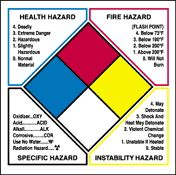 Communicate workplace hazards with handy labels from Safety Emporium. |
The Agency recognizes, however, that the standard's language permits two alternative methods of complying with the labeling provision when labeling bulk shipments of hazardous chemicals. Label information must either be attached to, or posted on the tank truck, tank car or similar vehicle, or place with the shipping papers in the vehicle; see my letter to you dated April 10. An employer may choose either method as long as the appropriate label accompanies the shipment.
|
You argue that both of these alternatives place an inappropriate burden on purchasers, requiring them to exert an active effort in ensuring that their employees are provided with labeling information. It has been suggested that OSHA permit labels to be separately mailed to purchasers at the time of each bulk shipment, or to send or mail labels at the time of the first shipment and, thereafter, only if the label is altered. Neither of these suggestions are permitted under the present HCS, nor do they seem appropriate for incorporation. HCS labels serve purposes other than merely informing a downstream employer of a chemical's identity and potential hazards so that he might, in turn, inform his employees. For example, labels accompanying shipments warn employees receiving the shipment of the cargo's chemical hazards. The label quickly confirms the shipment's identity and the hazard it poses. Mailing a label separately would not serve employees that handle the incoming shipment. In addition, although the HCS's primary purpose was to protect manufacturing employees from chemical hazards, labels are expressly required on all containers of hazardous chemicals shipped by chemical manufacturers, importers and distributors regardless of their destination, so that all workers, manufacturing and non-manufacturing, will be alerted to the presence of hazardous chemicals and the availability of more detailed hazard information elsewhere. Mailing labels to purchasers will bypass those employees involved in transporting the hazardous chemical or goods. |  We've got your DOT number at Safety Emporium with DOT placards, NFPA labels and more! |
This HCS material safety data sheet transmittal requirements for distributors are specifically limited in the standard. Pursuant to paragraphs 1910.1200(b)(1) and (g)(7), distributors are only required to pass along a material safety data sheet to manufacturing purchasers or to other distributors who supply manufacturers. The standard does not require distributors to create such information. On March 26, a guidance memorandum relating to this issue, was mailed to OSHA Regional Administrators (copy enclosed).
This guidance memorandum should answer many of the questions raised in your letter. In an effort to ensure that the issues you raised are clarified, each of your questions (page 3 of your letter) is answered below. Also enclosed for your review is a letter I sent to Edward Merrigan, Counsel for the National Association of Recycling Industries (NARI) discussing many of these same issues.
In some cases the distributor may be in a better position to create a material safety data sheet than the manufacturing user who receives the scrap. In most cases the manufacturing user will be a secondary smelter or foundry operator who is likely to have more knowledge and capabilities concerning the characteristics of metals. These industries are considered chemical manufacturers under the HCS and as such are required to comply with the standard's requirements for chemical hazard determination and creation of material safety data sheets.
Sincerely,
John B. Miles, Jr.
Director
Directorate of Field Operations
Enclosures
April 24, 1986
Mr. Patrick Tyson
Assistant Secretary for
Occupational Safety and Health
Occupational Safety and Health Administration
U.S. Department of Labor
200 Constitution Avenue, N.W.
Washington, DC 20210
Dear Mr. Tyson:
|
We are writing in an attempt to ascertain exactly what compliance posture the Agency has adopted toward enforcement of the Hazard Communication Standard (HCS) insofar as it may apply to the metallic scrap processing industry. Nearly two years ago, in the summer of 1984, we met with Ms. Jennifer Silk of your staff to identify this industry's compliance obligations under the HCS. At that time, we expressed some uncertainty over the meaning of the terms "distributor" and "article" as defined in the Standard, and sought direction from the Agency on exactly what requirements would be imposed on scrap processors when the Standard took effect in 1985. Ms. Silk responded unequivocally that scrap processors are "distributors" under the Standard. Additionally, Ms. Silk stated that metallic scrap would not be considered an "article" because under normal conditions of use (i.e., recycling through re-melting), the material could be expected to release a "hazardous chemical" in the form of metallic fumes or dusts. | 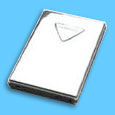 Your MSDS collection can always be up to date with this 400,000+ MSDS database from Safety Emporium. |
With this clear statement of Agency intent, we began a comprehensive program to provide information to our member companies and to draft the necessary materials (i.e., metallic scrap MSDS's) which they would need for compliance. As a result of the expenditure of hundreds of man-hours of staff time, and many thousands of dollars in material costs, we finalized a compliance program for our members well in advance of the Standard's compliance deadline. Material Safety Data Sheets were provided for distribution to purchasers, and detailed compliance instructions were issued to members. The scrap processing industry, at least that portion which is represented by this Institute, was capable of compliance with the Standard by November 25, 1985.
In the course of this effort, we again sought guidance from the Agency, this time concerning an interpretation of the labeling requirement under 29 CFR 1910.1200 (f)(1). We initially assumed that "container" included tank trucks and the like (OSHA Instruction CPL 2-2.38). We inquired whether this interpretation also applied to trucks, rail cars, and similar vehicles used to transport metallic scrap in bulk. Field Operations personnel responded that the Agency intended to enforce the Standard's labeling requirement to include precisely admittedly unusual circumstances involving vehicles, the Agency proposed to modify the Standard by interpretation: such bulk "containers" used to transport metallic scrap or other so-called "hazardous chemicals" would not have to be directly labeled; instead, a label would have to attached to the "shipping papers" for such material.
| Severe procedural difficulties arose in complying with the new directive. As a result, we again contacted Field Operations and attempted to reach a compromise which would meet the objective of the standard's labeling provision, but permit a reasonable alternative approach to compliance. After extended discussion, a Field Operating representative agreed verbally with our suggested approach. We sought written confirmation of the Agency's concurrence in a letter to Mr. John Miles dated December 5, 1985 (copy enclosed). In this letter, we summarized our understanding of the Standard's requirements, and requested a modification in the Agency's labeling requirement for bulk shipments of metallic scrap. The requested modification, for bulk shipments of metallic scrap. The requested modification, for bulk shipments only, would have permitted labels to be provided in the same way MSDS's are provided: at the time of initial shipment, and subsequently only upon request or upon modification of the label's contents. The Agency agreed with our suggested approach (see enclosed copy of Mr. Mile's letter dated January 14, 1986), and we accordingly advised our members. |  This handy poster explains the common hazardous chemical labeling systems. Get yours at Safety Emporium. |
The results of all this interchange between the Institute and the Agency can be summarized as follows:
We now learn of a March 26 memorandum to Regional Administrators from Mr. Miles under which the Agency apparently asserts it will not enforce a requirement that MSDS's be provided by scrap processors, unless the MSDS's are originally provided by the "manufacturer" of the metallic scrap.
| We seem to have some full circle. For nearly two years, Agency personnel have consistently stated that MSDS's must be provided by scrap processors, even if it means preparing the documents on their own. Just five days after Mr. Miles' memorandum apparently was issued, the Institute conferred with Field Operations concerning unrealistic labeling requirements. Despite an exchange of letters and a face-to-face meeting with Mr. Miles and his staff, and despite their inability to find any fault with our proposed labeling alternative (except to say the proposal does not comfort with the letter of the Standard), we are told that scrap processors must label all their metallic scrap shipments. In light of the recent memorandum, does this mean that an MSDS is not required from a distributor unless he has been provided one, but a label is always required? |  Safety Emporium.com carries hundreds of extinguisher signs and accessories! |
At this point, we would appreciate a clear statement of Agency policy on this matter. Since our members must attempt to comply with the regulations, they deserve an answer to these questions:
Sincerely,
David M. Wassum
Director of Safety
Enclosures
April 22, 1986
Mr. John B. Miles, Jr.
Director
Directorate of Field Operations
Occupational Safety and Health Administration
U.S. Department of Labor
200 Constitution Ave., NW
Washington, DC 20210
Dear Mr. Miles:
| We have received your letter dated April 10, 1986 concerning labeling requirements under the Hazard Communication Standard. As you will recall, when we met with you and your staff on March 31, we discussed in detail the impracticality of the Standard's labeling requirements as applied to bulk shipments of metallic scrap. At that time, you indicated that a decision had not yet been made concerning OSHA's position on this issue. We specifically requested the opportunity to meet with you and Acting Assistant Secretary Tyson, if necessary, to again explain our position on this issue before another official interpretation was issued, which would alter the conclusion of the prior OSHA letter on the subject. Since your letter was sent without our being granted the meeting with Mr. Tyson which your staff assured us would be an available option, and since you have neglected to return our subsequent telephone calls, we are forced to respond to your latest action in writing. |  Comply with state and federal regulations with hazardous waste labels fromSafety Emporium. |
You responded by letter on January 14, 1986, noting: "It would be acceptable to send an appropriate label to each purchaser prior to or at the time of initial shipment along with the explanatory letter you propose."
Nowhere in your letter was it suggested or implied that additional labels would have to be sent with each subsequent shipment.
In your latest letter, you suggest that we "misinterpreted the intent" of your earlier "guidance." We unambiguously described a prudent approach to labeling bulk shipments (see attached copy of letter), and you unambiguously pronounced the procedure "acceptable" (see attached copy of your response). Obviously, we have no way of ascertaining the Agency's "intent." However, to imply that we somehow misinterpreted your words is simply wrong.
Despite our attempts to explain the impracticality of the OSHA labeling program when applied to metallic scrap shipped in bulk, you have totally failed to address the problem. We explained that providing labels with "shipping papers" was impractical, since many bulk shipments are transported without any paper documentation. In your most recent letter, you attached an excerpt from Department of Transportation regulations, purporting to demonstrate that "shipping papers" must accompany every shipment of hazardous material. You apparently fail to realize that metallic scrap, in almost all cases, is not a "hazardous material" under DOT regulations. The issue remains: how do you attach a label to shipping papers (or incorporate label language into such documents), if no "shipping papers" exist?
Aside from that practical shortcoming, serious conceptual problems are present in OSHA's suggested procedure which demonstrate a lack of understanding of how many businesses operate. The purpose of a label, obviously, is to provide hazard information to employees in the workplace who may be exposed to certain hazards. A label on a container of material which is present in the work area may accomplish this objective.
| For bulk shipments, however, you suggest that the "label" must be attached to or incorporated in some ill-defined "shipping document." Even when such documents exist, their ultimate destination will certainly be someplace other than the work area where the shipped material will be used, or where employees exposure may occur. The "shipping paper" (whether a manifest, an invoice, or some other document) will be directed to the purchasing, accounting, or similar administrative office -- not to the work area where the material will be used. Indeed, the document's destination may well be in a different location or even a different state than that in which the workplace is located. There is no basis to assume that any workplace benefit will automatically accrue because some warning language is included in, for example, an invoice. Indeed, during our last meeting in your office, you agreed that to merely generate paper was not the purpose of the program. You also agreed that it was more important to get the message to the workplace than to perfectly prepare labels that would most likely end up in places other than the workplace, in many cases the trash receptacle. | 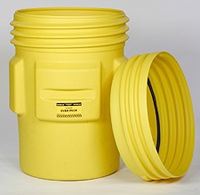 Contain leaky drums with overpack containers from Safety Emporium. |
We explained these problems in great detail to you and your staff on March 31. No one disputed the logic of our position. We therefore assumed that the Agency would re-affirm our procedure, since it would achieve the worthy informational objectives of the Standard's labeling requirement, at the same time avoiding the clear practical shortcomings of the original OSHA interpretation on the subject. Instead, the Agency appears intent on enforcing a poorly conceived procedure which will not accomplish the Standard's objective, but will impose massive paperwork requirements on industry.
Despite the lack of understanding and the refusal to consider substantive issues, we remain hopeful that a reasonable resolution of this matter can be achieved. Accordingly, we look forward to your prompt response.
Sincerely,
David M. Wassum
Director of Safety
April 10, 1986
Mr. David M. Wassum
Director of Safety
Institute of Scrap Iron and Steel, Inc.
1627 K Street, N. W.
Washington, D. C. 20006
Dear Mr. Wassum:
|
On January 14, 1986, I wrote you in response to your request for interpretation on certain requirements of Occupational Safety and Health Administration's (OSHA) Hazard Communication Standard (HCS). Subsequently, I have learned that your organization has misinterpreted the intent of our guidance on the labeling requirements of the HCS. The issue concerned the physical infeasibility and practical difficulties involved with placing labels on scrap and scrap shipments. Similar infeasibility problems also apply to the bulk transfer of chemicals by tank or hopper trucks and rail cars. OSHA recognizes these difficulties and permits an alternative. Where it is infeasible to affix labels to bulk containers such as rail cars or trucks carrying bulk shipments, labels must be attached to the shipping papers accompanying the product. Label information meeting the requirements of paragraph (f) of 29 CFR 1910.1200 may be incorporated into shipping documents, in lieu of attaching separate labels, as long as such information is clearly identified. In other words, shipping paperwork may be modified to include a new block of information identified as OSHA labeling requirements. | 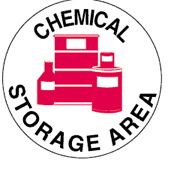 Encourage proper work habits with non-slip floor markers, signs, and labels from Safety Emporium. |
This does not and was not intended to negate the duty to provide label information with each and every shipment.
The transmission requirements for material safety data sheets and labels are different under the HCS. Material safety data sheets do not have to be sent with every shipment. Paragraph (g)(6) of the HCS reads "chemical manufacturers or importers shall ensure that distributors and manufacturing purchasers of hazardous chemicals are provided an appropriate material safety data sheet with their initial shipment and with the first shipment after a material safety data sheet is updated."
With respect to labels, paragraph (f)(1) of the HCS reads "the chemical manufacturer, importer, or distributor shall ensure that each container of hazardous chemicals leaving the workplace is labeled, tagged or marked..."
To summarize, the interpretation that label information may accompany each shipment in lieu of being affixed is already an accommodation under the HCS. The misinterpretation that only one transmission is required would not be in compliance with the standard.
I hope that this clarifies our interpretation. Please feel free to contact us again if further assistance is needed.
Sincerely,
John B. Miles, Jr., Director
Directorate of Field Operations
January 14, 1986
Mr. David M. Wassum
Director of Safety
Institute of Scrap Iron and Steel, Inc.
1627 K Street, N. W.
Washington, D.C. 20006
Dear Mr. Wassum:
|
This is in response to your letter requesting guidance concerning the labeling requirements of the Hazard Communication Standard, 29 CFR 1910.1200, as applied to scrap metal. Please accept my apology for the delay in response. The warning language which you propose for use on the labels would not be satisfactory in all situations since you are referencing only the aspects of fume generation during melting. The dusts generated by some metals, such as lead oxide dust which is easily dissociated from the metal in the reclaiming of lead cable, can also be hazardous. For example, airborne overexposures to lead can result from the handling of reclaimed lead cable. The warning language you propose for the label would be acceptable only for those metals which would not create an airborne dust exposure during handling of the reclaimed metal. The wording would need to be modified to warn against potential dust exposures when appropriate. We have reviewed your proposed advice to your member companies concerning the provision for labeling shipments of metallic scrap. It would be acceptable to send an appropriate label to each purchaser prior to or at the time of initial shipment along with the explanatory letter you propose. This method of supplying a label separately would be appropriate only for bulk shipments of scrap metals. | 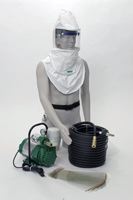 If you work with respirable dusts, consider a complete supplied air respirator system like this one from Safety Emporium. |
Please do not hesitate to contact us again if you need further assistance.
Sincerely,
John B. Miles, Jr., Director
Directorate of Field Operations
December 5, 1985
Mr. Patrick Tyson
Assistant Secretary for
Occupational Safety and Health
Occupational Safety and Health Administration
U.S. Department of Labor
200 Constitution Avenue N.W.
Washington, D.C. 20210
|
Dear Mr. Tyson: On behalf of the Institute of Scrap Iron and Steel and its member companies, we are seeking an official interpretation of Certain requirements of the Hazard Communication Standard (29 CFR 1910.1200). Specifically, we are concerned with the labeling requirements of 29 CFR 1910.1200(f)(1), and the definition of "container" at 29 CFR 1910.1200(c). The institute of Scrap Iron and Steel represents over 1200 companies primarily engaged in processing of metallic scrap for recycling (SIC 5093). It is our understanding, based on prior conversations with OSHA officials, that metallic scrap processors are subject to certain Hazard Communication Standard requirements for two reasons: scrap processors are included within the definition of "distributor" specified in 29 CFR 1910.1200 (c); and metallic scrap is not exempted as an "article" because its expected end use is in recycling by re-melting, and under those conditions it could release potentially hazardous fumes. As the standard is currently written, we understand that the following obligations apply to scrap processors effective November 25, 1985: |  Get this interactive Fire Prevention CD course (and lots of other safety stuff) at Safety Emporium. |
The problem of determining appropriate warning language for metallic scrap labels is particularly difficult. Under ordinary shipping, storage, and handling circumstances, metallic scrap obviously presents no appreciable hazard. Indeed, for most metallic scrap, the requirements of the Hazard Communication Standard would not even apply under these circumstances. The potential hazards arise, and the standard's requirements are triggered, because metallic scrap ultimately will be melted. When this process occurs, potentially harmful fumes may be released. Unfortunately, the exact chemical composition of a particular metallic scrap shipment is not ordinarily known. The only feasible approach for identifying composition, and the method we used in developing metallic scrap Material Safety Data Sheets, is to list the potential ranges of each element which reasonably can be expected to be present in a particular type of scrap metal (e.g., aluminum scrap, carbon steel scrap, etc.). The difficulty with this approach is that specific potential hazards cannot be identified with certainty, since the potential hazards depend on the presence and the actual concentration of particular chemical elements within the scrap. The complexity and range of potential hazards can reasonably be addressed on a document such as a Material Safety Data Sheet. They cannot be adequately addressed in the abbreviated format of a label. Therefore, out of necessity, metallic scrap labels must include only a general warning, with specific information provided by the relevant Material Safety Data Sheet. These problems were discussed in some detail with Mr. Healy, and he concurred that the following warning language would be sufficient for use on labels pertaining to metallic scrap:
"During melting, may release fumes which could be harmful if Inhaled. Consult MSDS for details." The other labeling problem confronting scrap processors concerns the definition of "container." There are two primary means by which metallic scrap is shipped: in drums, and similar structures; and in bulk, via rail cars, trucks, and the like. Clearly, the former method (drums, boxes, etc.) involves the use of "containers," each of which must be labeled in accordance with the standard. In contrast, bulk shipments are not typically thought to involve "containers," and reasonable doubt exists whether such shipments would require labels.
Mr. Healy stated OSHA's position that bulk transportation vehicles are in fact "containers" under the Hazard Communication Standard, and therefore technically would require labels. However, in consideration of the somewhat unusual circumstances involved, he indicated that modified labeling procedures should be followed in such cases. Specifically, the OSHA interpretation enunciated by Mr. Healy required that an appropriate label should be sent with shipping documents pertaining to each bulk shipment of metallic scrap, in lieu of labeling the vehicle(s). In addition to the label, Mr. Healy suggested that the scrap processor include an explanatory letter, describing the suggested use of the label on the purchaser's premises.
This requirement, at least insofar as it applies to the scrap processing industry, is impractical, overly burdensome, and ineffective. Several significant problems exist. First, the standard imposes no obligation on transporters to preserve or deliver the labels which are attached to the shipping papers by the shipper. Therefore, there is no assurance that the labels will reach the intended recipient, the manufacturing purchaser. Secondly, in many cases (particularly for rail and intermodal shipments), no "shipping papers" actually accompany the shipment to destination. Transportation is arranged entirely by telephone or electronic communication, eliminating the paper documentation which formerly existed, or the documents move from the shipper to the carrier, not the receiver. In such cases, there is no paperwork to which a label could be affixed, even if required, or if there is a shipping document, it does not go to the receiver's workplace.
| In addition to the interpretation's procedural shortcomings, a significant practical difficulty exists in complying with the labeling requirement as interpreted. Much of the metallic scrap sold for recycling is brokered through one or more intermediate companies. These brokerage firms and intermediates usually perform no material processing. Instead, they typically combine loads of scrap from multiple sources, and functions may be performed by intermediate without actually taking physical possession of the material, but simply by managing the transportation of the material from source to ultimate purchaser. Under OSHA's interpretation of the labeling requirement, these intermediates will be responsible for collecting labels from multiple suppliers and forwarding appropriate labels to manufacturing purchasers. Completion of this task will be physically impossible in many cases, since there often goes to a particular destination. In addition, distribution of identical labels with each shipment will only compound the paperwork burden, while adding nothing to the protection of manufacturing purchasers' employees. |  If you work around dust or chemicals you should have an eye wash like this one from Safety Emporium. |
It is readily apparent that OSHA's labeling requirement, as originally interpreted, presents some severe procedural and practical problems for shipments of bulk scrap metal. The practical solution to these problems is to require the separate provision of a label, by mail or otherwise, directly to the purchaser at the time of initial shipment. The same procedure used to provide Material Safety Data Sheets to purchaser would be adequate for insuring that labels are also provided to a purchaser for use in protecting employees in the purchaser's workplace.
Because of the difficulties posed by OSHA's labeling interpretation, we attempted to discuss this situation again with Mr. John Miles on December 3, 1985, and were directed to Mr. Joe Hopkins of the Field Operations staff. During a telephone discussion on December 3, 1985, Mr. Hopkins concurred that the purpose of the standard's labeling requirement is to get information into the workplace, not to label vehicles in transit. He also agreed that our proposed procedure (i.e., providing labels for bulk shipments in the same manner that Material Safety Data Sheets are provided) would be an acceptable method of fulfilling this requirement.
Accordingly, in response to verbal instructions from your Field Operations staff, we intend to advise our member companies of these specific requirements for labeling shipments of metallic scrap:
| Clearly, we believe that this procedure will provide conditions which are actually more protective of employee health, but at least as safe and healthful as those provided under OSHA's interpretation of the labeling requirement. The scrap processor or intermediate will have the responsibility for providing appropriate labels to each purchaser. (Under OSHA's interpretation, the scrap processor must only provide a label to the transporter. The purchasing employer will have the responsibility for using the provided label to placard or otherwise mark the work area(s) where the hazards may be present. (The purchaser has the identical responsibility now under OSHA's labeling interpretation.) Thus, this suggested procedure will provide equal (or greater) protection to employees, and reduce the burden on all parties. | 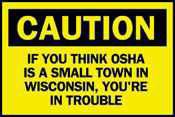 SafetyEmporium.com carries both serious and humorous signs. |
Sincerely,
David M. Wassum
Director of Safety
The official, public domain, OSHA version of this document is available at http://www.osha.gov/pls/oshaweb/owadisp.show_document?p_table=INTERPRETATIONS&p_id=19468&p_text_version=FALSE